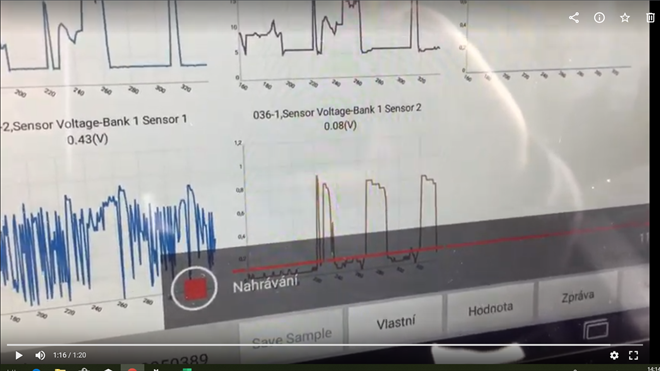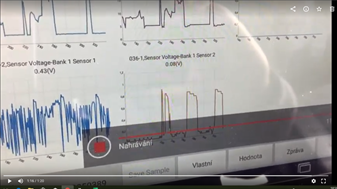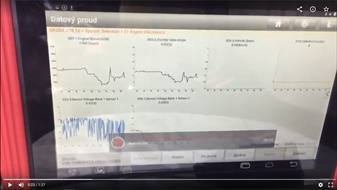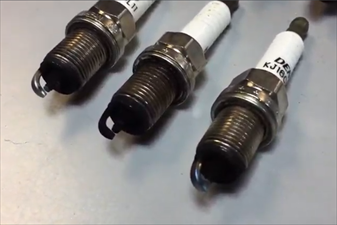

A friend technician calls up. One, that you can't refuse and says: "I have a Škoda here with a 1.2 HTP - MPi 3-cylinder engine that is running on 2 cylinders." Several possibilities run through my head straight away, but he immediately adds that the: "Ignition coils, spark plugs and fuel injectors have been replaced with new parts, so the problem can't be caused by any of these!"
The testing in my workshop reveals that the exhaust gases are returning back and the friend who is helping finds out that this is caused by the catalytic converter, where one half is clogged. The converter damage is a result of the engine running on 2 cylinders and is not a cause. Based on the fact that the fuel injectors, spark plugs and ignition coils are not defective (according to the friend), the friend decides that the cylinder head is going to have the valve guides repaired. There is some play between the valve stems and the valve guides, but this play is clearly not causing the cylinder misfire. Cylinder head repair took 2 weeks.
After replacing the catalytic converter and reinstalling the overhauled cylinder head the engine is still running on 2 cylinders!
I have started from the beginning and on my own now. I am getting different results than my friend. Before it was cylinder #1 misfire now cylinder #2 is misfiring. From the LOG recording, I can see misfire on all cylinders.
After a short while the engine ECU activates the MIL light and is reporting that the "A/F mixture is too rich". This engines on-board diagnostic system doesn't register cylinder misfire immediately but it takes 5 minutes. This is despite the fact that the engine is shaking very strongly for 2 minutes at idle.
When I see that all the spark plugs are black, I deceive the engine ECU by simulation so that the ECU doesn't see/ignores oxygen content in the exhaust and then I can measure the ignition system. I have registered some minor differences on the primary circuit saturation current and I can see shunt sparks on cylinder #2 (the results are black fouled spark plugs).
Now I swapped the ignition modules and injectors between the individual cylinders. What a surprise, the fault travelled to the cylinder where initially only the fuel injector was swapped! The result is that I installed a new fuel injector and cleaned the carbon fouled spark plugs with a gas torch and the engine is running OK.
What is the learnt lesson: Trust and believe? Never and nobody! The friend didn't lie but wasn't aware of facts that are explained in detail in this diagnostic story. He was influenced by his experience because he has overhauled over 50 of these simple and basic 3 cylinder engines and he made a terminal mistake by overlooking facts that he may have never seen before, even on more sophisticated engines that he repaired. We should never underestimate, even the simplest faults and treat every case with the same utmost importance and care.
Visit and explore our training courses on the FCD.eu website.
Read the complete detailed story in our archive with a description of all the mistakes that shouldn't happen even on the simplest and basic cars.

The signal of the monitoring Lambda sensor behind the 3-way catalytic converter is sitting at idle at almost 0 volts and is reporting together with the upstream Lambda sensor, that there is "too much oxygen content" in the exhaust gases. The engine ECU is responding by adding fuel to the injected quantity to it's maximum limit, causing the MIL light to turn On and a DTC code "Mixture too rich" to be stored in memory. In this situation we can't be surprised that there are misfires on all 3 cylinders and not just on cylinder #2, because the A/F mixture is just too rich.

At idle the engine is vibrating strongly. The engine misfire counter (top right) is not registering that the engine is running on 2 cylinders and the misfire counter is showing a "zero"! The misfire counter begins to count after about 5 minutes, once the Lambda sensors enrich the mixture so much, that all the cylinders start to misfire (all spark plugs are black). We can't be surprised that the owner destroyed the catalytic converter because too much petrol was injected into cylinder #2 as a result of, that the engine ECU didn't know about the misfires

If for any reason (defective Lambda sensor, corroded terminals, small leak in the exhaust, etc.) a low voltage signal appears on the Lambda sensor and this leads to major mixture enrichment. In these situations, to continue with diagnosis that isn't affected by the increased fuel injection quantity as a result of the ECU strategy, it is necessary to use a "simulation" trick so that the ECU doesn't increase the injected fuel quantity...

The engine management system doesn't know that the oxygen in the exhaust comes from a "lean mixture" and so it unfortunately adapts the fuel quantity for all cylinders. This is something that we do not want to see during diagnostics so we have to arrange that the feedback system doesn't respond at all. The result of the system being cheated is that "something" will either happen or that nothing will happen. If the presence of oxygen in the exhaust was to be caused by a leaking exhaust system, all the spark plugs would be clean without any carbon fouling. Under no circumstances would this cause fouling of only one spark plug! After applying the simulation trick we can clearly see a black spark plug only on cylinder #2. This is the purpose of our simulation trick, that no manufacturers offer in their troubleshooting methods. Maybe we can say, "thanks goodness" for FCD.eu :-)
Kompletní informace na toto téma
a mnoho dalších informací najdete pod odkazy níže.
Vyzkoušejte si nás nezávazně na 14 dní zdarma.
Vyzkoušet 14 dní zdarma
Komentáře (0)
Vložit soubor